J. Brit. Astron. Assoc., 107, 5, 1997, p.238
Using a Barlow lens and focal reducer
by Maurice Gavin

Sunrise over the lunar crater Theophilus: 1997 January 14 at 17.17 UT; 30cm f/10 SCT with ×2 teleconverter and SX mono CCD in 0.02s exposure. Resolution better than 1 arcsecond reveals craters smaller than a kilometre across. By subtracting in the computer the main image from one taken 100 minutes later (lower left), subtle changes in the surface illumination are made obvious (lower right). Here the mid-grey areas are still in full shadow whilst the sinuous black lines are either the reducing shadow-line on the crater floor or mountain peaks now catching the first rays of sunlight. (M. V. Gavin)
A telescope's fixed focal length and image scale cannot satisfy all conditions particularly when capturing images onto film or CCD. These images, taken with a Meade LX200 SCT, show the application of the Barlow lens to increase the focal length to reveal fine detail, and a focal reducer (FR) to increase sky coverage.
The latter are relatively new to the astronomical scene and directly relate to the popular Schmidt-Cassegrain telescope (SCT) which are typically of a 'slow' f/10 f/ratio and 2m to 3m in focal length. An FR forfeits resolution for image scale and introduces optical aberrations of its own. It may be better to use a telescope of inherently shorter focal length, if available. However an FR, in shortening the telescope's effective focal length, will still retain the telescope's full aperture and so a 'fast' optical system results with shorter exposures on extended objects. Typical SCT FRs convert an f/10 system to about f/6.3. Recently Optec introduced an f/3.3 FR for CCD use on f/10 SCTs, effectively increasing the field of view by three, sky coverage and 'speed' by a factor of nine.
The Optec FR is very expensive and experiments were made with camera lenses to see if one could serve a similar purpose. A lens of 85mm focal length and 43mm aperture (Russian f/2 Jupiter lens/Pentax thread) gave acceptable results although coma and some vignetting were evident. It screws direct into the Starlight Xpress (SX) faceplate with an adaptor ring coupling the lens filter thread to the Meade backplate and converts the f/10 beam into f/2.9. The system is focused via the telescope's focusing knob and the helical focusing ring on the lens.
For a Barlow lens I prefer to use a photographic equivalent called a teleconverter which can be of superior optical and mechanical design with a wide throat to minimise vignetting. Available in M42/Pentax thread they also screw direct into the SX faceplate and with intervening photographic extension tubes the magnification can be varied.


Above: Orion Nebula M42, 1996 February 28, 30cm SCT and SX-L8 CCD in 40 second exposures. (Left): Inner Trapezium region at f/10; (right): full frame via 2.9 focal reducer. Vignetting can be reduced if a flat-field calibration frame is applied. (M. V. Gavin)
Return to Journal 1997 October contents page


